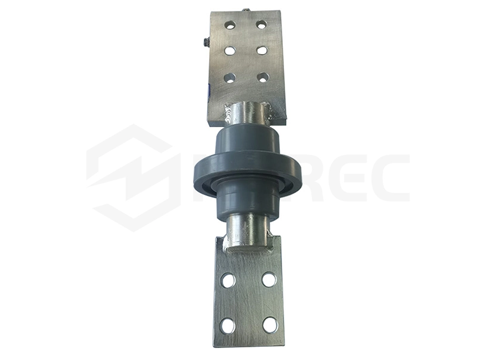- All
- Product Name
- Product Keyword
- Product Model
- Product Summary
- Product Description
- Multi Field Search
Email: sales@njrecgroup.com
Views: 0 Author: Site Editor Publish Time: 2025-06-16 Origin: Site
Transformer bushings are critical components in power transformers, providing the insulated passageway for high-voltage conductors to connect the transformer's internal windings to external circuits. These bushings must withstand high electrical stresses, environmental challenges, and mechanical loads, ensuring safety and reliable operation of the transformer.
Two of the most common bushing materials used today are porcelain and epoxy resin. Each has unique properties, advantages, and limitations that influence their suitability for specific transformer applications. As power systems evolve—demanding higher reliability, compactness, and environmental resilience—the choice between porcelain and epoxy resin bushings becomes increasingly important.
Before comparing materials, it's essential to understand the role and structure of transformer bushings.
A transformer bushing allows electrical conductors to safely pass through grounded transformer enclosures while maintaining robust insulation to prevent short circuits or electrical leakage. The bushing must handle:
High voltages (often tens or hundreds of kilovolts)
Mechanical stresses from conductor weight and external forces
Environmental factors such as moisture, pollution, UV radiation, and temperature extremes
The choice of insulating material directly affects the bushing’s electrical strength, mechanical durability, and long-term reliability.
Porcelain bushings are made from ceramic materials, primarily kaolin, feldspar, and quartz. These raw materials are shaped and fired at high temperatures, creating a hard, dense ceramic with excellent insulating properties. The porcelain housing is usually glazed to protect it from moisture and contamination.
Electrical insulation: Porcelain provides excellent dielectric strength and surface resistance, maintaining insulation integrity even in high-voltage applications.
Mechanical strength: The material has high compressive strength but is brittle and can crack or shatter under impact or sudden mechanical shock.
Environmental resistance: Porcelain bushings are highly resistant to UV radiation, weathering, and pollution, making them suitable for outdoor installations.
Weight and Size: Porcelain bushings tend to be heavy and bulky due to their dense ceramic material.
Proven track record with decades of reliable service
Superior resistance to environmental degradation (e.g., pollution, UV exposure)
High dielectric strength suitable for very high voltage applications
Fire-resistant and chemically stable
Heavy weight complicates transportation and installation
Brittle nature makes them susceptible to mechanical damage
Manufacturing is less flexible; designs are more constrained to traditional shapes
Maintenance and handling require care to prevent cracks

Epoxy resin bushings are made by molding solid epoxy resin mixed with fillers and reinforcement materials around the conductor. Modern manufacturing includes internal electrostatic grading layers to manage electrical stress distribution, improving insulation performance.
Electrical insulation: Epoxy resin has excellent dielectric strength and allows precise control of electric field distribution, reducing the risk of partial discharge.
Mechanical strength: The material is tough and impact-resistant, providing high mechanical strength while being less brittle than porcelain.
Environmental resistance: Epoxy resin bushings are sealed, providing excellent resistance to moisture ingress. They perform well in polluted and humid environments.
Weight and Size: Epoxy resin bushings are lightweight and can be molded into compact, customized shapes.
Lightweight and compact, facilitating easier handling and installation
High mechanical toughness and impact resistance
Excellent moisture resistance due to sealed design
Flexibility in manufacturing enables customized shapes for optimized space usage
Environmentally friendly as they contain no heavy metals or ceramics requiring firing
Compatible with both oil-immersed and dry-type transformers
Less UV resistant than porcelain unless specially treated
Historically shorter service history compared to porcelain (though modern designs have proven longevity)
Potential for aging or degradation if exposed to extreme UV without proper coatings
Both porcelain and epoxy resin provide excellent dielectric properties. Porcelain’s long-established performance under extreme voltages remains a benchmark, while epoxy resin’s internal grading layers help control electric field distribution, reducing stress and extending lifespan. Epoxy resin bushings often perform better in reducing partial discharges.
Epoxy resin’s impact resistance and toughness make it less prone to damage from shocks and vibrations compared to porcelain, which is brittle. This advantage is critical during transportation and installation in urban or challenging environments.
Porcelain is naturally resistant to UV, pollution, and weathering. Epoxy resin bushings require additional UV protective coatings for outdoor use but excel in moisture resistance due to sealed designs. In heavily polluted or coastal environments, epoxy resin’s hydrophobicity reduces contamination buildup.
Epoxy resin bushings are considerably lighter and more compact, easing installation and reducing support structure requirements. Porcelain bushings’ heavy weight requires more robust mechanical supports.
Porcelain’s known lifespan often exceeds 30 years with proper care, while modern epoxy resin bushings demonstrate comparable durability with lower maintenance due to sealed construction. Epoxy resin bushings also allow integration of sensors for predictive maintenance.
Porcelain bushings can be more expensive due to heavier materials and complex firing processes. Epoxy resin bushings benefit from efficient molding techniques and lower shipping costs due to reduced weight.
Preferred for outdoor, high-voltage transformers where environmental resistance is paramount
Traditional substations and large power plants
Locations with harsh UV and pollution levels where porcelain’s weather resistance is advantageous
Urban substations with space constraints requiring compact design
Dry-type transformers and indoor applications
Renewable energy installations such as solar inverters and wind turbine transformers
Locations requiring robust moisture and contamination resistance
Systems incorporating smart grid technology and sensor integration
Choosing between epoxy resin and porcelain bushings depends on specific application requirements, environmental conditions, mechanical constraints, and long-term maintenance considerations.
Porcelain bushings offer proven durability and outstanding environmental resistance, making them ideal for many outdoor, high-voltage applications. In contrast, epoxy resin bushings provide a lightweight, compact, and mechanically robust alternative suited for modern transformer designs, especially where space is limited or moisture resistance is critical.
As power systems evolve towards smart, compact, and sustainable solutions, epoxy resin bushings are gaining traction. For manufacturers and utility providers seeking reliable, advanced insulating solutions, partnering with experienced companies such as Nanjing Rainbow Electric Co., Ltd. can ensure access to cutting-edge bushing technologies tailored to diverse transformer needs.
For more detailed product information and technical support, visit www.njrecinsulator.com.